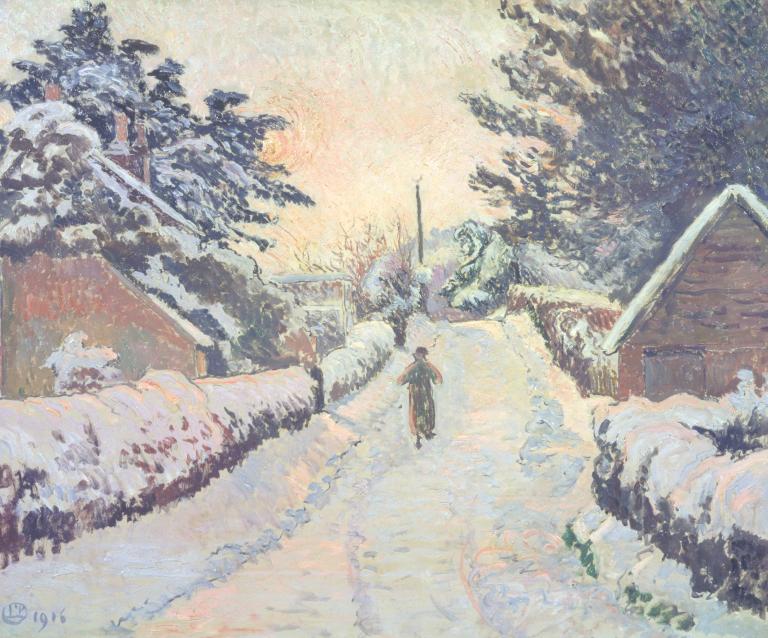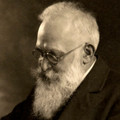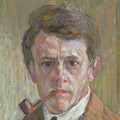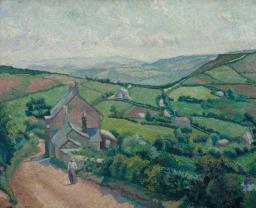Lucien Pissarro Ivy Cottage, Coldharbour: Sun and Snow 1916
Lucien Pissarro,
Ivy Cottage, Coldharbour: Sun and Snow
1916
In this snow scene the sun rests low in the sky, partially obscured by a fir tree on the left-hand side, mixing shadow and light in the pink and blue patches cast on the snow. A figure walks along the road with coat collar turned up, a trail of footprints indicated with brushstrokes of pinkish grey. On the left of the painting is Ivy Cottage, where the Pissarros lived at this time, in the village of Coldharbour in Surrey.
Lucien Pissarro 1863–1944
Ivy Cottage, Coldharbour: Sun and Snow
1916
Oil paint on canvas
530 x 644 mm
Inscribed ‘LP’ in monogram and ‘1916’ bottom left, and ‘Ivy Cottage (Sunset Snow) Coldharbour’ in pencil on stretcher top member
Presented by the Trustees of the Chantrey Bequest 1943
N05552
1916
Oil paint on canvas
530 x 644 mm
Inscribed ‘LP’ in monogram and ‘1916’ bottom left, and ‘Ivy Cottage (Sunset Snow) Coldharbour’ in pencil on stretcher top member
Presented by the Trustees of the Chantrey Bequest 1943
N05552
Ownership history
Bought from the artist by Geoffrey Blackwell (1884–1943) in 1916; after his death in 1943 exhibited for sale at Arthur Tooth & Son, London, where purchased by the Trustees of the Chantrey Bequest in April 1943 and presented to Tate Gallery.
Exhibition history
1916
Fifty-Fifth Exhibition of Modern Pictures held by the New English Art Club, The Galleries, Suffolk Street, London, Summer 1916 (40, as ‘Ivy Cottage (sun and snow)’).
1916
Autumn Exhibition, Walker Art Gallery, Liverpool 1916 (223, as ‘Ivy Cottage (sun and snow)’).
1925
Special Retrospective Exhibition (1886–1934) and Seventy-First Exhibition held by the New English Art Club, Spring Garden Gallery, London, January–February 1925 (180), Manchester City Art Gallery, April–May 1925 (114, as ‘Ivy Cottage – Sun and Snow’).
1928
Modern Art: Autumn Exhibition, French Gallery, London 1928 (37, as ‘Sunset and Snow’).
1943
Exhibition of Pictures from a Private Collection, Arthur Tooth & Son, London, April–May 1943 (16, as ‘Ivy Cottage, Cold Harbour, 1916’, £60).
1944
Summer Exhibition, Royal Academy, London, April–August 1944 (21, as ‘Ivy Cottage, Coldharbour’).
1944–5
A Selection from the Tate Gallery’s Wartime Acquisitions (Second Exhibition), (Council for the Encouragement of Music and the Arts tour), Manchester City Art Gallery, November–December 1944, City Museum and Art Gallery, Birmingham, January–February 1945, Walker Art Gallery, Liverpool, March 1945, Central Museum and Art Gallery, Derby, April 1945, Wakefield Art Gallery, May–June 1945, Castle Museum, Norwich, July–August 1945, Laing Art Gallery, Newcastle upon Tyne, September–October 1945, Worthing Museum and Art Gallery, October–November 1945 (56, reproduced pl.4).
1945
The Tate Gallery’s Wartime Acquisitions Second Exhibition, National Gallery, London, June–July 1945 (54, reproduced pl.4).
1946–7
Modern British Pictures from the Tate Gallery, (British Council tour), Palais des Beaux-Arts, Brussels, January–February 1946 (67, reproduced), Stedelijk Museum, Amsterdam, March 1946 (67, reproduced), Raadhushallen, Copenhagen, April–May 1946 (67), Musée du Jeu de Paume, Paris, June–July 1946 (67, reproduced), Musée des Beaux-Arts, Berne, August 1946 (69), Akademie der Bildenden Kunste, Vienna, September 1946 (70, reproduced), Narodni Galerie, Prague, October–November 1946 (70), Muzeum Narodwe, Warsaw, November–December 1946 (70, reproduced), Galleria d’Arte Moderna, Rome, January–February 1947 (70), Tate Gallery, London, May–September 1947 (5552, reproduced pl.11 as ‘Ivy Cottage, Coldharbour’).
1947–8
Modern British Pictures from the Tate Gallery, (Arts Council tour), Leicester Museum and Art Gallery, September–October 1947, Graves Art Gallery, Sheffield, October–November 1947, Birmingham City Museum and Art Gallery, November–December 1947, Bristol City Art Gallery, January–February 1948, Russell-Cotes Art Gallery, Bournemouth, February–March 1948, Brighton Art Gallery and Museum, March–April 1948, Plymouth Art Gallery, April–May 1948, Castle Museum, Nottingham, May–June 1948, Huddersfield Museum and Art Gallery, June–July 1948, Aberdeen Art Gallery, July–August 1948, Salford Art Gallery and Museum, August–September 1948 (48, as ‘Ivy Cottage, Coldharbour’, reproduced pl.7).
1949
The Chantrey Collection, Royal Academy, London, January–March 1949 (303, as ‘Ivy Cottage, Coldharbour’).
1958
A Selection from the Chantrey Bequest, Graves Art Gallery, Sheffield, April 1958 (71, as ‘Ivy Cottage, Coldharbour’).
1963
Lucien Pissarro 1863–1944: A Centenary Exhibition of Paintings, Watercolours, Drawings and Graphic Work, (Arts Council tour), Arts Council Gallery, London, January–February 1963, Manchester City Art Gallery, March 1963, Bristol City Art Gallery, April 1963, Dundee City Art Gallery, May 1963, The Minories, Colchester, June 1963, Ashmolean Museum, Oxford, July 1963 (36).
1988–97
Chequers, Buckinghamshire 1988–97 (long loan).
References
1951
Hesketh Hubbard, A Hundred Years of British Painting 1851–1951, London and New York 1951, reproduced pl.78.
1962
W.S. Meadmore, Lucien Pissarro: Un Coeur Simple, London 1962, p.152.
1963
J. Cornforth, ‘A French Impressionist in England’, Country Life, vol.123, no.3437, 17 January 1963, pp.98–9.
1965
Mary Chamot, Dennis Farr and Martin Butlin, Tate Gallery: The Modern British Paintings, Drawings and Sculpture, vol.2, London 1965, pp.527–8.
1983
Anne Thorold, A Catalogue of the Oil Paintings of Lucien Pissarro, London 1983, no.228, reproduced p.121, as Ivy Cottage (Sunset and Snow) Coldharbour.
Technique and condition
Ivy Cottage, Coldharbour: Sun and Snow is painted on a plain linen canvas with a pre-primed commercial white oil ground. It is stamped ‘H.J. Pursey, Shepherds Bush Rd, Hammersmith’. The smooth white ground is visible in areas such as the foreground.
It is very freely and confidently painted with linear brushstrokes drawing much of the composition. The application involves far fewer dabs of paint than in Pissarro’s earlier impressionist work. The paint is fluid with extended drips of paint drawn out across the surface. There is a greater variety of thickness from impasto to unpainted areas, but no glazing. Pissarro has used a narrow range of colours with pink and yellow sunlight falling on the snow and trees and cool blue shadows. He has drawn with paint in a strong dark blue expressive line, particularly evident in the foreground where there is much exposed ground, for instance the road gutter on the left is covered with the least amount of paint. There are few campaigns of colour application and a restrained and directed approach predictably achieving a less laboured result.
This work is varnished but stains from the varnish are visible on the reverse having penetrated through the cracks, suggesting it is not original. The work is in fairly good condition but the varnish detracts from the surface quality of the painting.
Stephen Hackney
June 2003
How to cite
Stephen Hackney, 'Technique and Condition', June 2003, in David Fraser Jenkins, ‘Ivy Cottage, Coldharbour: Sun and Snow 1916 by Lucien Pissarro’, catalogue entry, October 2002, in Helena Bonett, Ysanne Holt, Jennifer Mundy (eds.), The Camden Town Group in Context, Tate Research Publication, May 2012, https://wwwEntry

Camille Pissarro 1830–1903
Fox Hill, Upper Norwood 1870
Oil paint on canvas
353 x 457 mm
National Gallery, London
Photo © National Gallery, London
Fig.1
Camille Pissarro
Fox Hill, Upper Norwood 1870
National Gallery, London
Photo © National Gallery, London
The cottage at the left, which almost disappears behind ivy, is the ‘Ivy Cottage’ of the title, where the Pissarros lived from November 1915 to July the following year.1 Coldharbour, near Leith Hill, south of Dorking in Surrey, was another remote village rather like Fishpond in Dorset where Pissarro had stayed the year before, and was again close to steep hills. He painted the view from the hills, and painted snow again the following winter, when he was living at East Knoyle in Wiltshire. His friend J.B. Manson wrote to Pissarro about the effects of snow on 2 February 1914:
I am sure you must be having a bad time in this cold weather. Are you getting any snow or frost effects? In London the snow and frost have looked quite big enough to be painted but of course I haven’t been able to do anything. The effects have been beautiful – subtle and mysterious. I am sorry you will not have been here to see them!2
Geoffrey Blackwell (1884–1943), who bought this landscape when it was first exhibited the year it was made, was the principal collector of paintings by the impressionist Philip Wilson Steer (1860–1941), and amassed from 1909 a large group of his works. He had wanted to buy one of the Stamford Brook snow pictures by Pissarro in 1913, at the opening of his Carfax Gallery exhibition, but was put off by the price of 120 guineas, which was extraordinarily high even for a large painting.3 Manson was pushing for a sale, and Blackwell wrote back to him:
Personally I think the Snow piece about the finest thing there and I should like to have had it but the price is quite ridiculous though I am told the owner does not really want to part with it ... I wish to discuss Pissarro and learn why you admire his work so and why you don’t admire Steer more.4
He invited Manson to lunch, and although he did not buy the painting this time he quickly bought this Coldharbour painting three years later. When writing about Blackwell’s collection in 1914, Manson concentrated inevitably on the Steers but added that ‘works of a different calibre or of different intention are being added’ to the collection, and then listed five Pissarros and reproduced two of them.5 The range of Blackwell’s collection was conservative, following Slade School staff and pupils and members of the New English Art Club, such as Henry Tonks, Augustus John, C.J. Holmes, George Clausen, Ambrose McEvoy and Glyn Philpot. Manson’s article mentions no other Camden Town Group artists as being part of the collection.
The recommendation for purchase of this painting was made by John Rothenstein, Director of the Tate Gallery, to the Royal Academy.6 The painting was singled out by John Cornforth in a review of the 1963 exhibition: ‘The dash and freedom of the Tate Gallery’s Ivy Cottage, Coldharbour: Sun and Snow is exceptional, and one wishes that he had painted more in this brilliant manner.’7
In 1988 the painting was lent to Chequers in Buckinghamshire, the official country house of the Prime Minister, following a request from Margaret Thatcher’s office for some modern British paintings to replace others that had had to be returned. It was retained by John Major, the next Prime Minister, but withdrawn when the Tate reviewed its loan policy in 1997.
David Fraser Jenkins
October 2002
Notes
Anne Thorold, A Catalogue of the Oil Paintings of Lucien Pissarro, London 1983, p.18. Orovida Pissarro confirmed the place in replying to an enquiry from the Tate Gallery of 16 September 1958: ‘Ivy Cottage is on the left of the picture and that is where my parents rented furnished rooms for a seasons painting.’ Tate Catalogue file.
J.B. Manson, ‘Mr Geoffrey Blackwell’s Collection of Modern Pictures’, Studio, vol.61, 15 May 1914, p.272.
Related biographies
Related catalogue entries
How to cite
David Fraser Jenkins, ‘Ivy Cottage, Coldharbour: Sun and Snow 1916 by Lucien Pissarro’, catalogue entry, October 2002, in Helena Bonett, Ysanne Holt, Jennifer Mundy (eds.), The Camden Town Group in Context, Tate Research Publication, May 2012, https://www




